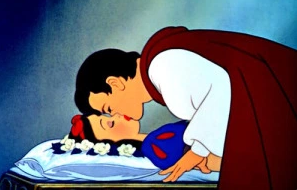Historical Roots
Disney’s characterization of men and women, especially in the early stages of the Disney Princess films, was shaped by societal gender norms and roles. When Disney princess movies were first released in the 1930s, the predominant cultural understanding of women was inextricably linked to their roles as housewives. In order to garner an audience and customer-base, Disney leveraged these notions and effectively portrayed them through their characters in Disney princess movies when the first princess movie, Snow White and the Seven Dwarfs, was released in 1937. Additionally, during the time of early movie production, almost all of the Walt Disney Company staff was male. The male employees created films that not only reflected the dominant perceptions of gender, but also were inherently biased as men at the time were deemed more capable than, and therefore superior to, women. Without men in the films, the women would often not have a purpose; the male characters, most often princes, are depicted as stable, and as important for the female characters to look to for support. This reflects the societal conventions of males as strong, adept figures, and females as demure and weak.
Disney Over Time
The representation of manliness in Disney princess movies has remained relatively constant throughout the decades, with little push from society to alter the stereotypical male depiction due to the predominance of the female discourse around gender roles. The princes are typically strong and confident, which at times, can come across as arrogance. Gaston from Beauty and the Beast is one of the most illustrious princes regarding these attributes. Gaston, in an effort to epitomize what he believes is a true man, has a huge ego, is tough, and expects Belle to fall for him. When Belle fails to do so, he gets very angry and irritable. Gaston is also white, attractive and buff, which sets an unrealistic standard for the physical attributes of an ideal man. Gaston is a figure to whom young boys and girls are exposed through Beauty and the Beast, and he serves as an example to boys to fight for what they want — such as money, power and women.
In a study centered on Disney princess movies, masculine and feminine characteristics of princes and princesses were assessed for a myriad of Disney princess movies. The study concluded that in the 1930s-50s, the movies portrayed more gendered attributes for both the princesses and the princes, as the characters employed more traditional gender roles when compared to the five films produced in and after the 1980s. The princes in the earlier films demonstrated gendered characteristics or were primarily absent from the film. For example, in Snow White, the prince was rarely shown, and it was not clear why the princess fell in love. Snow White seemed to have been chosen by the Prince and as a result, fell in love after he kissed her, freeing her from her morbid slumber. Furthermore, in Cinderella, the prince helps to shape the storyline, but plays a small role on screen overall. The traditional characterization of the prince does not allow for the demonstration of feminine behavior, such as looking after appearance, loss of power and hopelessness, i.e., crying and being ashamed.
The primary exceptions to the typical roles of princes emerge in Aladdin, where the prince is the primary focus of the movie, and The Princess and the Frog, where the prince is depicted as incompetent. Saying this, there are times when the prince does exhibit feminine characteristics; the ability for men to be more androgynous – portraying stereotypical and non-stereotypical gender roles – lends itself to a certain power, reinforcing hegemonic masculinity.
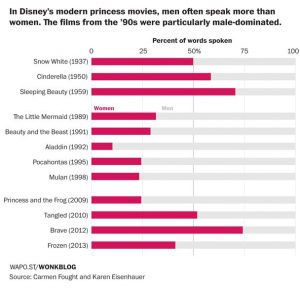
This is a chart depicting the ratio of men and women speech-time in the Disney Princess movies. Most of the films are male-dominated.
A Closer Look
Sleeping Beauty
The entire plot of Sleeping Beauty revolves around Prince Philip and his efforts to save Princess Aurora, with whom he falls in love based simply on her looks, from her curse. For much of the film, Aurora remains asleep, and when she finally awakes, she immediately falls in love with Prince Philip. Aurora is depicted as the beautiful, damsel-in-distress who is saved by the strong and independent prince. Sleeping Beauty reinforces the notions that the prince needs to rescue the princess, as she is incompetent, i.e., cursed to sleep, otherwise.
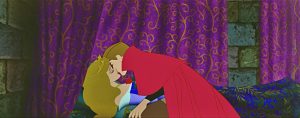
This image is highly problematic, as the Prince Philip is physically subjugating Aurora to his power as he awakens her with a kiss. Aurora is the female object of male desire, and only achieves salvation through this kiss. The romantic gesture also underlines the notions of heterosexual romance, which are reproduced in Disney princess movies.
The Little Mermaid
In The Little Mermaid, Prince Eric is the force that makes Ariel want to become human; Ariel’s independence and ability to become human is contingent on remaining with Eric, and she ends up giving up her future for a man. Thus, Prince Eric’s power and influence shape the narrative of the entire movie. This plot line overshadows the mix of traditional and non-traditional roles that Prince Eric does exhibit; in a study, Prince Eric was found to be emotional, affectionate and physically weak the same number of times that he is strong, brave and fearless. Although there is evidence of a more equal distribution of character traits, these examples are masked by the movie’s overall premise.
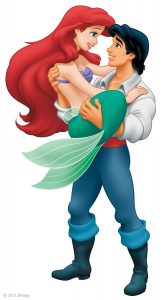
This is an image of Prince Eric holding Ariel. She is gazing into his eyes and relying on Eric, especially as she does not have her own feet to stand on at the time that this image was taken.
Snow White and the Seven Dwarfs
In the first Disney princess movie, Snow White, men are depicted as powerful, decisive, aggressive and heroic, while women are figures who can simply offer looks and the ability to do housework. The prince in the film does not have a large presence, but the few times that he is shown, his traits are typically masculine; for example, when Snow White rejects him, he continues in his pursuit to win her over. The prince is seen as bold and goal-oriented, following his desires to secure the beautiful Snow White. Additionally, at the end of the film, when Snow White is enveloped in a death-like sleep after consuming the poison apple, the Prince is the only character who can save her with a kiss. The Prince protects the weak Snow White, and is bold and independent in his actions.
Mulan
Mulan is a unique example of a Disney Princess film where the construction of the Princess is in fact an example of the creation of male identity. In the movie, Mulan has to become a man to save her father’s life under the constructs of the society in which she lives. Mulan takes her father’s spot in the Chinese military, and ends up rejecting her femininity because she does not perfectly for the mold. When Mulan is discovered to be a woman, there is a tremendous loss of respect by her comrades. However, at the end of the film, Mulan becomes her individual self, and does not give up her masculine traits. Although this notion of ‘becoming oneself’ is progressive, the evolution of Mulan’s character still reinforces the superior male roles of serving as military protectors.
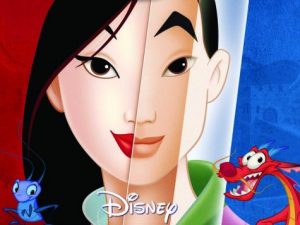
This image demonstrates the two personas that Mulan encapsulates in the film. She creates a dual personality to conform to the societal norms, i.e., has to become a man to save her father’s life.
Caroline Wolfe
